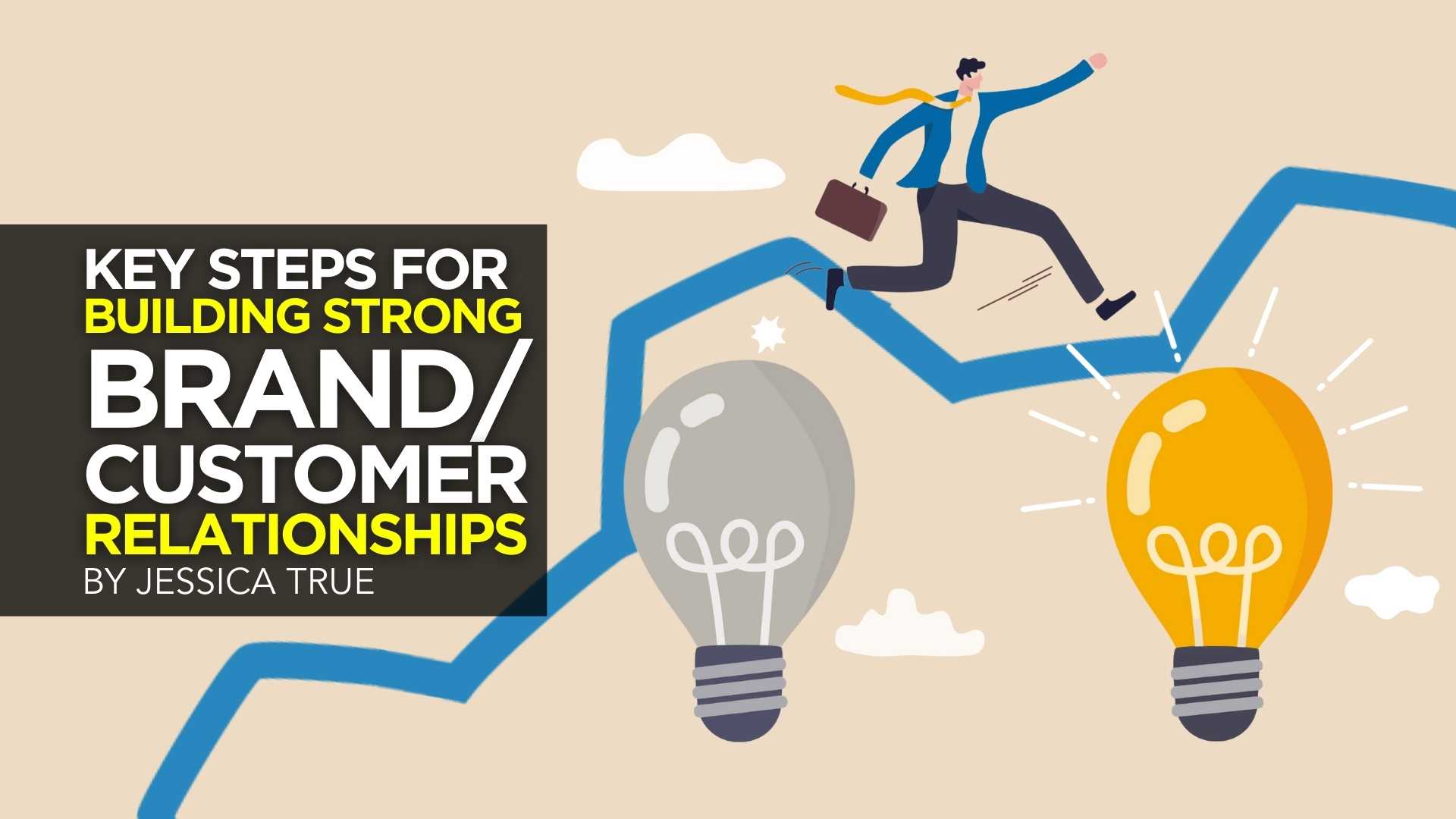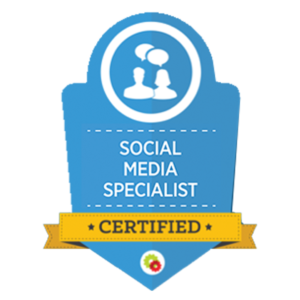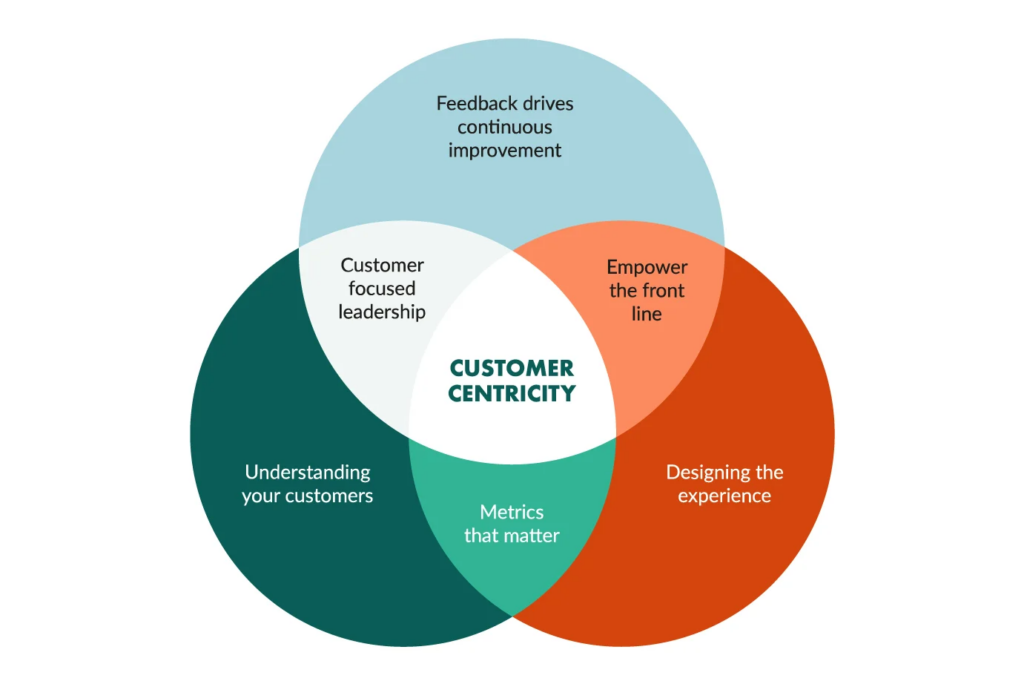MARKETING
Key Steps for Building Strong Brand/Customer Relationships

In modern business, standing out from the crowd isn’t easy. A strong brand-customer relationship is vital, as it drives customer loyalty and engagement. This can be the deciding factor in your business’s long-term success.
This article will explore the importance of your brand-customer relationship. We’ll explain how the four principles of brand management can help you build and maintain that relationship.
What is a Brand-Customer Relationship?

Your brand-customer relationship is the connection between your business and its customers. It’s influenced by various factors, but is essentially formed through the perception and reputation of your brand. You build this relationship on trust, loyalty, and engagement.
As well as the quality of the products or services you offer, your company’s reputation is also important. So is the customer’s overall experience with your brand. To put it simply, there are both tangible and intangible aspects to your brand-consumer relationship.
The tangible aspects include the quality of your products and services, as well as your sales, customer service, and support. We measure and affect the intangible parts of the brand-customer relationship with brand management.
Why is Brand-Customer Relationship Important?
It’s well-known that customer experience is one of the most critical factors in customer loyalty – and your brand-customer relationship is central to this. A good relationship encourages customer loyalty through engagement.

Customers who have a positive experience with your brand, and thus a strong brand-customer relationship, are more likely to recommend your company to others and make repeat purchases. This drives higher customer lifetime values and can grow your revenue through word-of-mouth and social sharing.
In addition, a solid brand-customer relationship helps to differentiate your business from its competitors. Positive associations with your brand make it easier for customers to identify and choose it over others.
The 4 Principles of Brand Management
So, now you know what we mean by a brand-customer relationship. But it probably still seems like a vague concept. Yet, whether you’re aware of it or not, you’re affecting it with everyday business decisions, advertising, and communications.
That’s why many established businesses have dedicated brand management teams to build consistency across your brand. These four overlapping principles guide brand management strategy. Measuring them will show you the state of your brand-customer relationship.
1. Awareness
This is how aware your target audience is of your brand versus others in your market. Think of synonymous brands such as Coke for soft drinks or Hoover for vacuums. These are the brands with the highest level of awareness in their respective areas.
Most businesses won’t become household names, but there are other ways to measure brand awareness. Analyzing organic searches for your brand name, as well as social media mentions, content shares, and so on, can give you a good idea of your audience’s awareness level.
That said, raising brand awareness isn’t just about getting your brand name in front of people. Increasing and maintaining awareness means you must also stand out in the customer’s memory. For brand managers, this means creating a unique brand personality for your business.
2. Reputation
Your reputation is what customers think about when they see your brand. This might be certain words or emotions they associate with your brand or product or a generally positive or negative sentiment.
This has a significant overlap with your brand awareness. If you’re not working on maintaining your brand reputation while growing awareness, you can spread negative sentiments and do more harm than good for your brand.
Building a positive reputation takes time. You can affect it through your communication, service, recruitment, and community projects. Your company culture, mission statement, and guiding principles can also tell external stakeholders about your reputation and values.

Are You Ready to Master Social Media?
Become a Certified Social Media Specialist and learn the newest strategies (by social platform) to draw organic traffic to your social media sites.
3. Loyalty
Research shows that loyal customers are five times more likely to make repeat purchases and four times more likely to recommend your business. That’s why customer loyalty is the goal of your efforts to improve your brand awareness and reputation.
Easier said than done? Perhaps. Customer loyalty can be challenging to build, partly because many customers look for different things to get their best experience out of a business. Some customers value convenience and price, while others want on-demand support.
For example, customers who come to your brand for value might appreciate your customer service measures such as a toll-free number or online text chat for inquiries. On the other hand, those looking for convenience might appreciate a premium-rate line that guarantees instant access to support.
That means that to increase customer loyalty, brand managers must analyze customer behavior and feedback. Personalization is a major driver of customer loyalty. When you listen to a customer’s needs and make changes based on feedback, you show that you value their contribution to your business.


4. Equity
Brand equity represents your brand’s perceived value. Think of it as the premium customers are willing to pay to access your brand over cheaper competitors. This leads to higher ROI on both new and developed products, as you can incorporate this into your pricing.
In his book, “Strategic Brand Management: Building, Measuring, and Managing Brand Equity”, author Kevin Lane Keller describes four key steps to building your brand equity:
- Establish your brand identity by identifying your target audience. Then, create your brand assets and stories around it.
- Define what your brand means. You do this by clearly stating your company values and through the projects you choose to support.
- Analyze how customers respond to your brand. What feelings and emotions does your brand evoke? Direct feedback and sentiment analysis are two good ways to judge this.
- Build your brand resonance by developing your existing customer relationships. Use your brand management to form deeper emotional connections with your customer base.
High customer satisfaction and customer loyalty are key indicators that your brand equity is rising.
How to Use Brand Management to Improve Customer Relations
Now you understand the principles of brand management, let’s look at how to use this in an everyday business setting to improve your customer relations.
Start With Brand Basics
If you’re new to brand management, the first step to improving customer relations is establishing a clear and consistent brand identity. This means developing a brand strategy, mission statement, and brand identity that aligns with your business’s values and goals.
You’ll also need to make key decisions about core brand assets like your logo design. Simple assets or slogans can be crucial in reinforcing the emotions and values you want customers to associate with your brand. Give these decisions the time and thought they deserve.
Share Your Stories
Whether we’re talking about your brand’s origin story, mission, or even employee journeys and customer testimonials, sharing these stories will help you make deeper emotional connections with your customers.
For example, many companies make support content like video tutorials for their products. But one way to make your customers feel more connected to this process is to share user-generated content with success tips and product guides.
Optimize Your Online Visibility
In today’s digital age, your business needs to have a strong online presence. Optimizing your online visibility can increase brand awareness and reach more customers.
This includes developing a website and creating social media profiles, as well as covering other basics like listing your brand in online directories and review sites.
Create an Internal Branding Guide
A strong brand identity is not just built by communicating with customers. You also need to ensure that employees understand and align with the company’s branding efforts. You can achieve this by creating an internal branding guide.
Use this as a reference for all employees to ensure consistency in tone of voice and other branding markers for all departments.
Focus on Your Customer Journey
It’s vital to understand how customers interact with your brand, from the awareness stage to post-purchase. By understanding the customer value journey, you can identify areas for improvement and tailor your branding efforts to meet the needs of your customers at each stage.


Engage Your Customers on Their Terms
Engaging with your customers on the channels they prefer is crucial to building a strong brand-customer relationship. Whether it’s social media, email, phone, or in-person interactions your audience prefers, make sure they can access your brand on those channels.
Personalize the Customer Experience
While we can fit customers into groups and demographics, each one is also unique. By analyzing a customer’s preferences as they interact with your business, you can give them a customer experience that meets their needs every time.
This can be small, simple, gestures. For example, give your priority customers access to a separate business phone number to speed up their support experience.
Analyze and Improve
Finally, to truly optimize your brand-customer relationship, you need to analyze your performance and make adjustments as you go. This includes tracking website traffic, monitoring social media engagement and sentiments, and analyzing customer feedback.



Are You Ready to Master Social Media?
Become a Certified Social Media Specialist and learn the newest strategies (by social platform) to draw organic traffic to your social media sites.
By using analytics, you can make data-driven decisions to improve customer relations and drive growth.
Final Thoughts: It’s all in the Details
Your brand-customer relationship goes deeper than your surface interactions with your customers. When we’re talking about subjective factors like emotion and engagement, the little details can make the biggest difference.
Even seemingly unrelated decisions like your choice of website hosting providers can have a knock-on effect. Does your domain name reflect your brand? Is it instantly recognizable to customers? When we think about it in these terms, it’s easy to see why a choice like this can have repercussions for your brand.
Effective brand management means you don’t have to fret about the small details of every decision. Having a clear brand strategy and documents like an internal branding guide help ensure consistency, even up to the decision-making level.
MARKETING
Ecommerce evolution: Blurring the lines between B2B and B2C

Understanding convergence
B2B and B2C ecommerce are two distinct models of online selling. B2B ecommerce is between businesses, such as wholesalers, distributors, and manufacturers. B2C ecommerce refers to transactions between businesses like retailers and consumer brands, directly to individual shoppers.
However, in recent years, the boundaries between these two models have started to fade. This is known as the convergence between B2B and B2C ecommerce and how they are becoming more similar and integrated.
Source: White Paper: The evolution of the B2B Consumer Buyer (ClientPoint, Jan 2024)
What’s driving this change?
Ever increasing customer expectations
Customers today expect the same level of convenience, speed, and personalization in their B2B transactions as they do in their B2C interactions. B2B buyers are increasingly influenced by their B2C experiences. They want research, compare, and purchase products online, seamlessly transitioning between devices and channels. They also prefer to research and purchase online, using multiple devices and channels.
Forrester, 68% of buyers prefer to research on their own, online . Customers today expect the same level of convenience, speed, and personalization in their B2B transactions as they do in their B2C interactions. B2B buyers are increasingly influenced by their B2C experiences. They want research, compare, and purchase products online, seamlessly transitioning between devices and channels. They also prefer to research and purchase online, using multiple devices and channels
Technology and omnichannel strategies
Technology enables B2B and B2C ecommerce platforms to offer more features and functionalities, such as mobile optimization, chatbots, AI, and augmented reality. Omnichannel strategies allow B2B and B2C ecommerce businesses to provide a seamless and consistent customer experience across different touchpoints, such as websites, social media, email, and physical stores.
However, with every great leap forward comes its own set of challenges. The convergence of B2B and B2C markets means increased competition. Businesses now not only have to compete with their traditional rivals, but also with new entrants and disruptors from different sectors. For example, Amazon Business, a B2B ecommerce platform, has become a major threat to many B2B ecommerce businesses, as it offers a wide range of products, low prices, and fast delivery
“Amazon Business has proven that B2B ecommerce can leverage popular B2C-like functionality” argues Joe Albrecht, CEO / Managing Partner, Xngage. . With features like Subscribe-and-Save (auto-replenishment), one-click buying, and curated assortments by job role or work location, they make it easy for B2B buyers to go to their website and never leave. Plus, with exceptional customer service and promotional incentives like Amazon Business Prime Days, they have created a reinforcing loyalty loop.
And yet, according to Barron’s, Amazon Business is only expected to capture 1.5% of the $5.7 Trillion addressable business market by 2025. If other B2B companies can truly become digital-first organizations, they can compete and win in this fragmented space, too.”
If other B2B companies can truly become digital-first organizations, they can also compete and win in this fragmented space
Joe AlbrechtCEO/Managing Partner, XNGAGE
Increasing complexity
Another challenge is the increased complexity and cost of managing a converging ecommerce business. Businesses have to deal with different customer segments, requirements, and expectations, which may require different strategies, processes, and systems. For instance, B2B ecommerce businesses may have to handle more complex transactions, such as bulk orders, contract negotiations, and invoicing, while B2C ecommerce businesses may have to handle more customer service, returns, and loyalty programs. Moreover, B2B and B2C ecommerce businesses must invest in technology and infrastructure to support their convergence efforts, which may increase their operational and maintenance costs.
How to win
Here are a few ways companies can get ahead of the game:
Adopt B2C-like features in B2B platforms
User-friendly design, easy navigation, product reviews, personalization, recommendations, and ratings can help B2B ecommerce businesses to attract and retain more customers, as well as to increase their conversion and retention rates.
According to McKinsey, ecommerce businesses that offer B2C-like features like personalization can increase their revenues by 15% and reduce their costs by 20%. You can do this through personalization of your website with tools like Product Recommendations that help suggest related products to increase sales.
Focus on personalization and customer experience
B2B and B2C ecommerce businesses need to understand their customers’ needs, preferences, and behaviors, and tailor their offerings and interactions accordingly. Personalization and customer experience can help B2B and B2C ecommerce businesses to increase customer satisfaction, loyalty, and advocacy, as well as to improve their brand reputation and competitive advantage. According to a Salesforce report, 88% of customers say that the experience a company provides is as important as its products or services.
Market based on customer insights
Data and analytics can help B2B and B2C ecommerce businesses to gain insights into their customers, markets, competitors, and performance, and to optimize their strategies and operations accordingly. Data and analytics can also help B2B and B2C ecommerce businesses to identify new opportunities, trends, and innovations, and to anticipate and respond to customer needs and expectations. According to McKinsey, data-driven organizations are 23 times more likely to acquire customers, six times more likely to retain customers, and 19 times more likely to be profitable.
What’s next?
The convergence of B2B and B2C ecommerce is not a temporary phenomenon, but a long-term trend that will continue to shape the future of ecommerce. According to Statista, the global B2B ecommerce market is expected to reach $20.9 trillion by 2027, surpassing the B2C ecommerce market, which is expected to reach $10.5 trillion by 2027. Moreover, the report predicts that the convergence of B2B and B2C ecommerce will create new business models, such as B2B2C, B2A (business to anyone), and C2B (consumer to business).
Therefore, B2B and B2C ecommerce businesses need to prepare for the converging ecommerce landscape and take advantage of the opportunities and challenges it presents. Here are some recommendations for B2B and B2C ecommerce businesses to navigate the converging landscape:
- Conduct a thorough analysis of your customers, competitors, and market, and identify the gaps and opportunities for convergence.
- Develop a clear vision and strategy for convergence, and align your goals, objectives, and metrics with it.
- Invest in technology and infrastructure that can support your convergence efforts, such as cloud, mobile, AI, and omnichannel platforms.
- Implement B2C-like features in your B2B platforms, and vice versa, to enhance your customer experience and satisfaction.
- Personalize your offerings and interactions with your customers, and provide them with relevant and valuable content and solutions.
- Leverage data and analytics to optimize your performance and decision making, and to innovate and differentiate your business.
- Collaborate and partner with other B2B and B2C ecommerce businesses, as well as with other stakeholders, such as suppliers, distributors, and customers, to create value and synergy.
- Monitor and evaluate your convergence efforts, and adapt and improve them as needed.
By following these recommendations, B2B and B2C ecommerce businesses can bridge the gap between their models and create a more integrated and seamless ecommerce experience for their customers and themselves.
MARKETING
Streamlining Processes for Increased Efficiency and Results

How can businesses succeed nowadays when technology rules? With competition getting tougher and customers changing their preferences often, it’s a challenge. But using marketing automation can help make things easier and get better results. And in the future, it’s going to be even more important for all kinds of businesses.
So, let’s discuss how businesses can leverage marketing automation to stay ahead and thrive.
Benefits of automation marketing automation to boost your efforts
First, let’s explore the benefits of marketing automation to supercharge your efforts:
Marketing automation simplifies repetitive tasks, saving time and effort.
With automated workflows, processes become more efficient, leading to better productivity. For instance, automation not only streamlines tasks like email campaigns but also optimizes website speed, ensuring a seamless user experience. A faster website not only enhances customer satisfaction but also positively impacts search engine rankings, driving more organic traffic and ultimately boosting conversions.
Automation allows for precise targeting, reaching the right audience with personalized messages.
With automated workflows, processes become more efficient, leading to better productivity. A great example of automated workflow is Pipedrive & WhatsApp Integration in which an automated welcome message pops up on their WhatsApp
within seconds once a potential customer expresses interest in your business.
Increases ROI
By optimizing campaigns and reducing manual labor, automation can significantly improve return on investment.
Leveraging automation enables businesses to scale their marketing efforts effectively, driving growth and success. Additionally, incorporating lead scoring into automated marketing processes can streamline the identification of high-potential prospects, further optimizing resource allocation and maximizing conversion rates.
Harnessing the power of marketing automation can revolutionize your marketing strategy, leading to increased efficiency, higher returns, and sustainable growth in today’s competitive market. So, why wait? Start automating your marketing efforts today and propel your business to new heights, moreover if you have just learned ways on how to create an online business
How marketing automation can simplify operations and increase efficiency
Understanding the Change
Marketing automation has evolved significantly over time, from basic email marketing campaigns to sophisticated platforms that can manage entire marketing strategies. This progress has been fueled by advances in technology, particularly artificial intelligence (AI) and machine learning, making automation smarter and more adaptable.
One of the main reasons for this shift is the vast amount of data available to marketers today. From understanding customer demographics to analyzing behavior, the sheer volume of data is staggering. Marketing automation platforms use this data to create highly personalized and targeted campaigns, allowing businesses to connect with their audience on a deeper level.
The Emergence of AI-Powered Automation
In the future, AI-powered automation will play an even bigger role in marketing strategies. AI algorithms can analyze huge amounts of data in real-time, helping marketers identify trends, predict consumer behavior, and optimize campaigns as they go. This agility and responsiveness are crucial in today’s fast-moving digital world, where opportunities come and go in the blink of an eye. For example, we’re witnessing the rise of AI-based tools from AI website builders, to AI logo generators and even more, showing that we’re competing with time and efficiency.
Combining AI-powered automation with WordPress management services streamlines marketing efforts, enabling quick adaptation to changing trends and efficient management of online presence.
Moreover, AI can take care of routine tasks like content creation, scheduling, and testing, giving marketers more time to focus on strategic activities. By automating these repetitive tasks, businesses can work more efficiently, leading to better outcomes. AI can create social media ads tailored to specific demographics and preferences, ensuring that the content resonates with the target audience. With the help of an AI ad maker tool, businesses can efficiently produce high-quality advertisements that drive engagement and conversions across various social media platforms.
Personalization on a Large Scale
Personalization has always been important in marketing, and automation is making it possible on a larger scale. By using AI and machine learning, marketers can create tailored experiences for each customer based on their preferences, behaviors, and past interactions with the brand.
This level of personalization not only boosts customer satisfaction but also increases engagement and loyalty. When consumers feel understood and valued, they are more likely to become loyal customers and brand advocates. As automation technology continues to evolve, we can expect personalization to become even more advanced, enabling businesses to forge deeper connections with their audience. As your company has tiny homes for sale California, personalized experiences will ensure each customer finds their perfect fit, fostering lasting connections.
Integration Across Channels
Another trend shaping the future of marketing automation is the integration of multiple channels into a cohesive strategy. Today’s consumers interact with brands across various touchpoints, from social media and email to websites and mobile apps. Marketing automation platforms that can seamlessly integrate these channels and deliver consistent messaging will have a competitive edge. When creating a comparison website it’s important to ensure that the platform effectively aggregates data from diverse sources and presents it in a user-friendly manner, empowering consumers to make informed decisions.
Omni-channel integration not only betters the customer experience but also provides marketers with a comprehensive view of the customer journey. By tracking interactions across channels, businesses can gain valuable insights into how consumers engage with their brand, allowing them to refine their marketing strategies for maximum impact. Lastly, integrating SEO services into omni-channel strategies boosts visibility and helps businesses better understand and engage with their customers across different platforms.
The Human Element
While automation offers many benefits, it’s crucial not to overlook the human aspect of marketing. Despite advances in AI and machine learning, there are still elements of marketing that require human creativity, empathy, and strategic thinking.
Successful marketing automation strikes a balance between technology and human expertise. By using automation to handle routine tasks and data analysis, marketers can focus on what they do best – storytelling, building relationships, and driving innovation.
Conclusion
The future of marketing automation looks promising, offering improved efficiency and results for businesses of all sizes.
As AI continues to advance and consumer expectations change, automation will play an increasingly vital role in keeping businesses competitive.
By embracing automation technologies, marketers can simplify processes, deliver more personalized experiences, and ultimately, achieve their business goals more effectively than ever before.
MARKETING
Will Google Buy HubSpot? | Content Marketing Institute

Google + HubSpot. Is it a thing?
This week, a flurry of news came down about Google’s consideration of purchasing HubSpot.
The prospect dismayed some. It delighted others.
But is it likely? Is it even possible? What would it mean for marketers? What does the consideration even mean for marketers?
Well, we asked CMI’s chief strategy advisor, Robert Rose, for his take. Watch this video or read on:
Why Alphabet may want HubSpot
Alphabet, the parent company of Google, apparently is contemplating the acquisition of inbound marketing giant HubSpot.
The potential price could be in the range of $30 billion to $40 billion. That would make Alphabet’s largest acquisition by far. The current deal holding that title happened in 2011 when it acquired Motorola Mobility for more than $12 billion. It later sold it to Lenovo for less than $3 billion.
If the HubSpot deal happens, it would not be in character with what the classic evil villain has been doing for the past 20 years.
At first glance, you might think the deal would make no sense. Why would Google want to spend three times as much as it’s ever spent to get into the inbound marketing — the CRM and marketing automation business?
At a second glance, it makes a ton of sense.
I don’t know if you’ve noticed, but I and others at CMI spend a lot of time discussing privacy, owned media, and the deprecation of the third-party cookie. I just talked about it two weeks ago. It’s really happening.
All that oxygen being sucked out of the ad tech space presents a compelling case that Alphabet should diversify from third-party data and classic surveillance-based marketing.
Yes, this potential acquisition is about data. HubSpot would give Alphabet the keys to the kingdom of 205,000 business customers — and their customers’ data that almost certainly numbers in the tens of millions. Alphabet would also gain access to the content, marketing, and sales information those customers consumed.
Conversely, the deal would provide an immediate tip of the spear for HubSpot clients to create more targeted programs in the Alphabet ecosystem and upload their data to drive even more personalized experiences on their own properties and connect them to the Google Workspace infrastructure.
When you add in the idea of Gemini, you can start to see how Google might monetize its generative AI tool beyond figuring out how to use it on ads on search results pages.
What acquisition could mean for HubSpot customers
I may be stretching here but imagine this world. As a Hubspoogle customer, you can access an interface that prioritizes your owned media data (e.g., your website, your e-commerce catalog, blog) when Google’s Gemini answers a question).
Recent reports also say Google may put up a paywall around the new premium features of its artificial intelligence-powered Search Generative Experience. Imagine this as the new gating for marketing. In other words, users can subscribe to Google’s AI for free, but Hubspoogle customers can access that data and use it to create targeted offers.
The acquisition of HubSpot would immediately make Google Workspace a more robust competitor to Microsoft 365 Office for small- and medium-sized businesses as they would receive the ADDED capability of inbound marketing.
But in the world of rented land where Google is the landlord, the government will take notice of the acquisition. But — and it’s a big but, I cannot lie (yes, I just did that). The big but is whether this acquisition dance can happen without going afoul of regulatory issues.
Some analysts say it should be no problem. Others say, “Yeah, it wouldn’t go.” Either way, would anybody touch it in an election year? That’s a whole other story.
What marketers should realize
So, what’s my takeaway?
It’s a remote chance that Google will jump on this hard, but stranger things have happened. It would be an exciting disruption in the market.
The sure bet is this. The acquisition conversation — as if you needed more data points — says getting good at owned media to attract and build audiences and using that first-party data to provide better communication and collaboration with your customers are a must.
It’s just a matter of time until Google makes a move. They might just be testing the waters now, but they will move here. But no matter what they do, if you have your customer data house in order, you’ll be primed for success.
HANDPICKED RELATED CONTENT:
Cover image by Joseph Kalinowski/Content Marketing Institute
-

 MARKETING7 days ago
MARKETING7 days agoRoundel Media Studio: What to Expect From Target’s New Self-Service Platform
-

 SEO6 days ago
SEO6 days agoGoogle Limits News Links In California Over Proposed ‘Link Tax’ Law
-
SEARCHENGINES6 days ago
Daily Search Forum Recap: April 12, 2024
-

 SEARCHENGINES5 days ago
SEARCHENGINES5 days agoGoogle Core Update Volatility, Helpful Content Update Gone, Dangerous Google Search Results & Google Ads Confusion
-

 SEO5 days ago
SEO5 days ago10 Paid Search & PPC Planning Best Practices
-

 SEO7 days ago
SEO7 days agoGoogle Unplugs “Notes on Search” Experiment
-

 MARKETING6 days ago
MARKETING6 days ago2 Ways to Take Back the Power in Your Business: Part 2
-

 MARKETING4 days ago
MARKETING4 days ago5 Psychological Tactics to Write Better Emails















